Google Certified Professional - Cloud Architect (GCP)
Last Update 20 hours ago
Total Questions : 275
Professional-Cloud-Architect is stable now with all latest exam questions are added 20 hours ago. Just download our Full package and start your journey with Google Certified Professional - Cloud Architect (GCP) certification. All these Google Professional-Cloud-Architect practice exam questions are real and verified by our Experts in the related industry fields.
For this question, refer to the EHR Healthcare case study. In the past, configuration errors put public IP addresses on backend servers that should not have been accessible from the Internet. You need to ensure that no one can put external IP addresses on backend Compute Engine instances and that external IP addresses can only be configured on frontend Compute Engine instances. What should you do?
For this question, refer to the EHR Healthcare case study. EHR has single Dedicated Interconnect
connection between their primary data center and Googles network. This connection satisfies
EHR’s network and security policies:
• On-premises servers without public IP addresses need to connect to cloud resources
without public IP addresses
• Traffic flows from production network mgmt. servers to Compute Engine virtual
machines should never traverse the public internet.
You need to upgrade the EHR connection to comply with their requirements. The new
connection design must support business critical needs and meet the same network and
security policy requirements. What should you do?
For this question, refer to the EHR Healthcare case study. You need to define the technical architecture for hybrid connectivity between EHR's on-premises systems and Google Cloud. You want to follow Google's recommended practices for production-level applications. Considering the EHR Healthcare business and technical requirements, what should you do?
For this question, refer to the Dress4Win case study. You are responsible for the security of data stored in
Cloud Storage for your company, Dress4Win. You have already created a set of Google Groups and assigned the appropriate users to those groups. You should use Google best practices and implement the simplest design to meet the requirements.
Considering Dress4Win’s business and technical requirements, what should you do?
For this question, refer to the Dress4Win case study. Dress4Win is expected to grow to 10 times its size in 1 year with a corresponding growth in data and traffic that mirrors the existing patterns of usage. The CIO has set the target of migrating production infrastructure to the cloud within the next 6 months. How will you configure the solution to scale for this growth without making major application changes and still maximize the ROI?
For this question, refer to the Dress4Win case study. To be legally compliant during an audit, Dress4Win must be able to give insights in all administrative actions that modify the configuration or metadata of resources on Google Cloud.
What should you do?
For this question, refer to the Dress4Win case study. Which of the compute services should be migrated as –is and would still be an optimized architecture for performance in the cloud?
For this question, refer to the TerramEarth case study.
TerramEarth has equipped unconnected trucks with servers and sensors to collet telemetry data. Next year they want to use the data to train machine learning models. They want to store this data in the cloud while reducing costs. What should they do?
For this question, refer to the TerramEarth case study.
To speed up data retrieval, more vehicles will be upgraded to cellular connections and be able to transmit data to the ETL process. The current FTP process is error-prone and restarts the data transfer from the start of the file when connections fail, which happens often. You want to improve the reliability of the solution and minimize data transfer time on the cellular connections. What should you do?
For this question, refer to the TerramEarth case study.
TerramEarth's CTO wants to use the raw data from connected vehicles to help identify approximately when a vehicle in the development team to focus their failure. You want to allow analysts to centrally query the vehicle data. Which architecture should you recommend?
A)
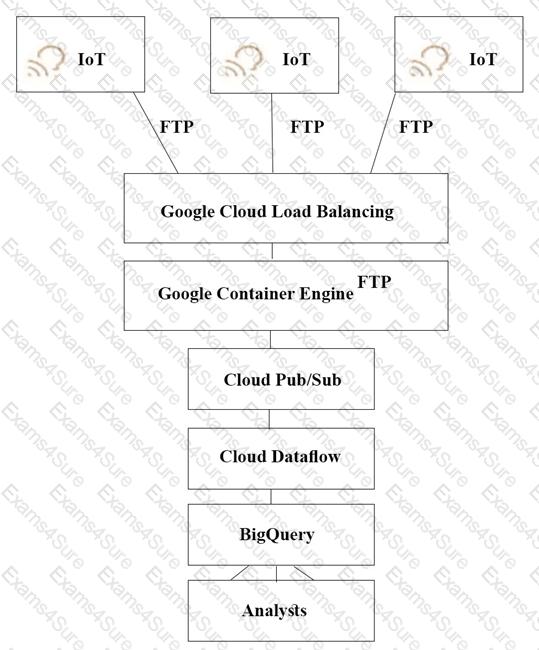
B)
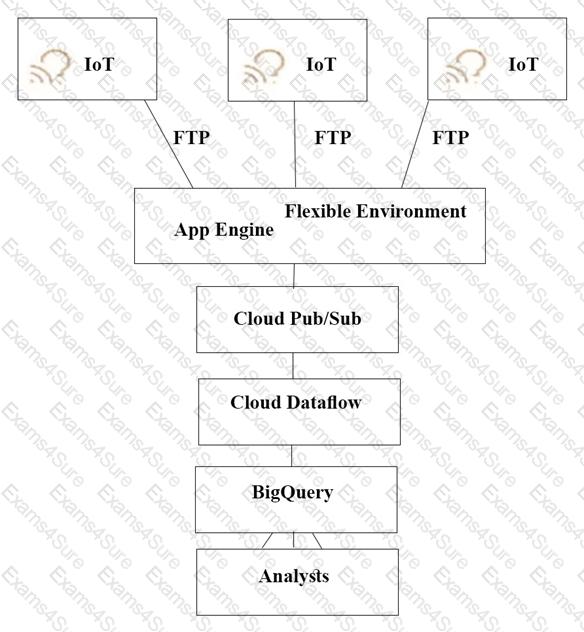
C)
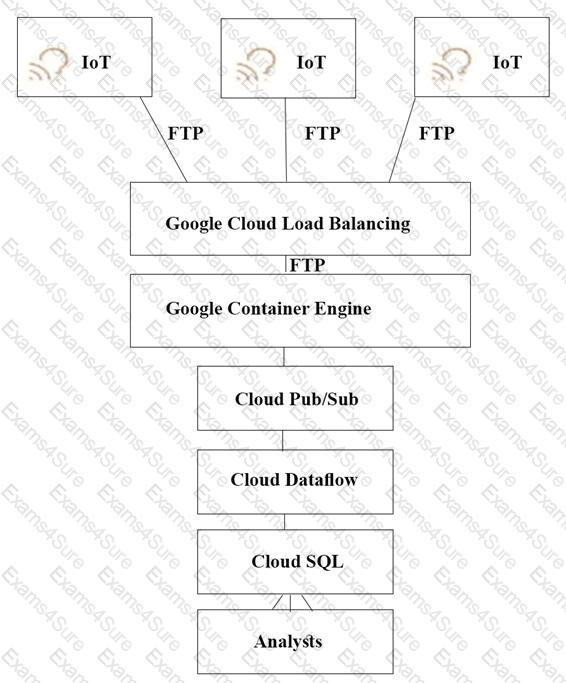
D)
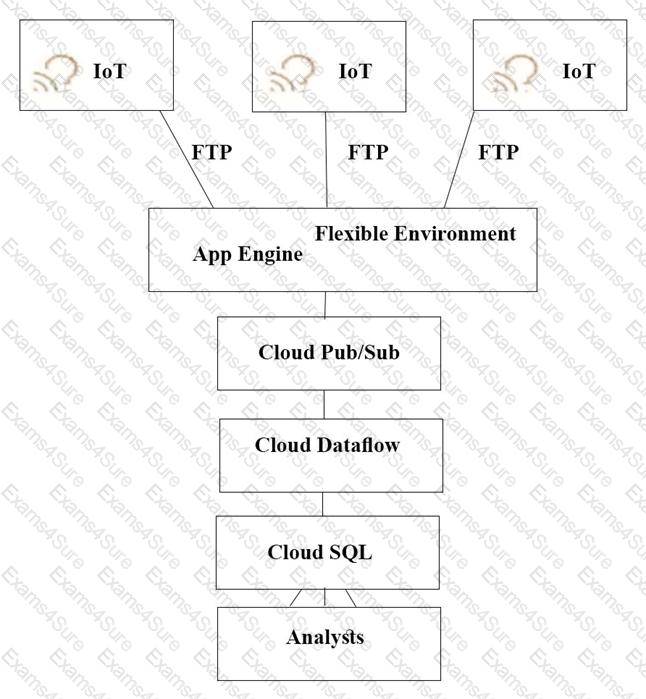
For this question, refer to the Helicopter Racing League (HRL) case study. The HRL development team
releases a new version of their predictive capability application every Tuesday evening at 3 a.m. UTC to a
repository. The security team at HRL has developed an in-house penetration test Cloud Function called Airwolf.
The security team wants to run Airwolf against the predictive capability application as soon as it is released
every Tuesday. You need to set up Airwolf to run at the recurring weekly cadence. What should you do?
For this question, refer to the TerramEarth case study.
TerramEarth plans to connect all 20 million vehicles in the field to the cloud. This increases the volume to 20 million 600 byte records a second for 40 TB an hour. How should you design the data ingestion?
For this question, refer to the Helicopter Racing League (HRL) case study. HRL is looking for a cost-effective
approach for storing their race data such as telemetry. They want to keep all historical records, train models
using only the previous season's data, and plan for data growth in terms of volume and information collected.
You need to propose a data solution. Considering HRL business requirements and the goals expressed by
CEO S. Hawke, what should you do?
For this question, refer to the Helicopter Racing League (HRL) case study. Recently HRL started a new regional
racing league in Cape Town, South Africa. In an effort to give customers in Cape Town a better user
experience, HRL has partnered with the Content Delivery Network provider, Fastly. HRL needs to allow traffic
coming from all of the Fastly IP address ranges into their Virtual Private Cloud network (VPC network). You are
a member of the HRL security team and you need to configure the update that will allow only the Fastly IP
address ranges through the External HTTP(S) load balancer. Which command should you use?
For this question, refer to the Helicopter Racing League (HRL) case study. HRL wants better prediction
accuracy from their ML prediction models. They want you to use Google’s AI Platform so HRL can understand
and interpret the predictions. What should you do?
For this question, refer to the JencoMart case study.
JencoMart has built a version of their application on Google Cloud Platform that serves traffic to Asia. You want to measure success against their business and technical goals. Which metrics should you track?
For this question, refer to the JencoMart case study.
The JencoMart security team requires that all Google Cloud Platform infrastructure is deployed using a least privilege model with separation of duties for administration between production and development resources. What Google domain and project structure should you recommend?
For this question, refer to the JencoMart case study.
JencoMart has decided to migrate user profile storage to Google Cloud Datastore and the application servers to Google Compute Engine (GCE). During the migration, the existing infrastructure will need access to Datastore to upload the data. What service account key-management strategy should you recommend?
For this question, refer to the JencoMart case study.
The migration of JencoMart’s application to Google Cloud Platform (GCP) is progressing too slowly. The infrastructure is shown in the diagram. You want to maximize throughput. What are three potential bottlenecks? (Choose 3 answers.)
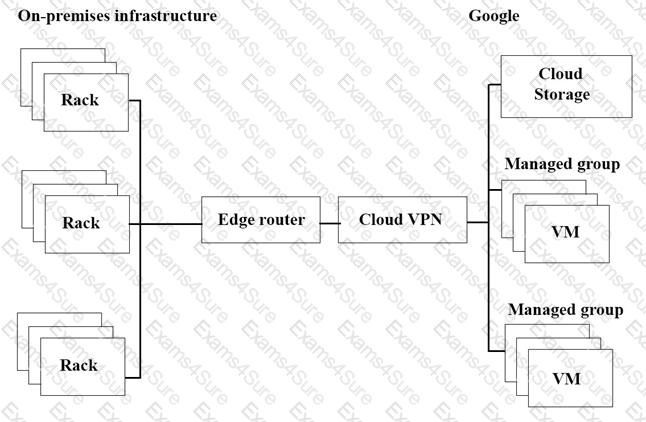
You have an application that will run on Compute Engine. You need to design an architecture that takes into account a disaster recovery plan that requires your application to fail over to another region in case of a regional outage. What should you do?
You need to deploy a stateful workload on Google Cloud. The workload can scale horizontally, but each instance needs to read and write to the same POSIX filesystem. At high load, the stateful workload needs to support up to 100 MB/s of writes. What should you do?
Your operations team has asked you to help diagnose a performance issue in a production application that runs on Compute Engine. The application is dropping requests that reach it when under heavy load. The process list for affected instances shows a single application process that is consuming all available CPU, and autoscaling has reached the upper limit of instances. There is no abnormal load on any other related systems, including the database. You want to allow production traffic to be served again as quickly as possible. Which action should you recommend?
A development manager is building a new application He asks you to review his requirements and identify what cloud technologies he can use to meet them. The application must
1. Be based on open-source technology for cloud portability
2. Dynamically scale compute capacity based on demand
3. Support continuous software delivery
4. Run multiple segregated copies of the same application stack
5. Deploy application bundles using dynamic templates
6. Route network traffic to specific services based on URL
Which combination of technologies will meet all of his requirements?
You are implementing Firestore for Mountkirk Games. Mountkirk Games wants to give a new game
programmatic access to a legacy game's Firestore database. Access should be as restricted as possible. What
should you do?
For this question, refer to the Mountkirk Games case study. You are in charge of the new Game Backend Platform architecture. The game communicates with the backend over a REST API.
You want to follow Google-recommended practices. How should you design the backend?
For this question, refer to the Mountkirk Games case study. Mountkirk Games wants you to design a way to test the analytics platform’s resilience to changes in mobile network latency. What should you do?
For this question, refer to the Mountkirk Games case study. Mountkirk Games wants to migrate from their current analytics and statistics reporting model to one that meets their technical requirements on Google Cloud Platform.
Which two steps should be part of their migration plan? (Choose two.)
The current Dress4win system architecture has high latency to some customers because it is located in one
data center.
As of a future evaluation and optimizing for performance in the cloud, Dresss4win wants to distribute it's system
architecture to multiple locations when Google cloud platform.
Which approach should they use?
For this question, refer to the Dress4Win case study.
As part of their new application experience, Dress4Wm allows customers to upload images of themselves. The customer has exclusive control over who may view these images. Customers should be able to upload images with minimal latency and also be shown their images quickly on the main application page when they log in. Which configuration should Dress4Win use?
For this question, refer to the Dress4Win case study.
Dress4Win has end-to-end tests covering 100% of their endpoints. They want to ensure that the move to the cloud does not introduce any new bugs. Which additional testing methods should the developers employ to prevent an outage?
Dress4win has end to end tests covering 100% of their endpoints.
They want to ensure that the move of cloud does not introduce any new bugs.
Which additional testing methods should the developers employ to prevent an outage?
You have broken down a legacy monolithic application into a few containerized RESTful microservices. You want to run those microservices on Cloud Run. You also want to make sure the services are highly available with low latency to your customers. What should you do?
For this question, refer to the TerramEarth case study. You are asked to design a new architecture for the
ingestion of the data of the 200,000 vehicles that are connected to a cellular network. You want to follow
Google-recommended practices.
Considering the technical requirements, which components should you use for the ingestion of the data?
You are migrating a Linux-based application from your private data center to Google Cloud. The TerramEarth security team sent you several recent Linux vulnerabilities published by Common Vulnerabilities and Exposures (CVE). You need assistance in understanding how these vulnerabilities could impact your migration. What should you do?
For this question, refer to the TerramEarth case study. To be compliant with European GDPR regulation, TerramEarth is required to delete data generated from its European customers after a period of 36 months when it contains personal data. In the new architecture, this data will be stored in both Cloud Storage and BigQuery. What should you do?
For this question, refer to the Mountkirk Games case study.
Mountkirk Games' gaming servers are not automatically scaling properly. Last month, they rolled out a new feature, which suddenly became very popular. A record number of users are trying to use the service, but many of them are getting 503 errors and very slow response times. What should they investigate first?
For this question, refer to the Mountkirk Games case study.
Mountkirk Games wants you to design their new testing strategy. How should the test coverage differ from their existing backends on the other platforms?
For this question, refer to the EHR Healthcare case study. You are responsible for designing the Google Cloud network architecture for Google Kubernetes Engine. You want to follow Google best practices. Considering the EHR Healthcare business and technical requirements, what should you do to reduce the attack surface?
For this question, refer to the Mountkirk Games case study.
Mountkirk Games wants to set up a continuous delivery pipeline. Their architecture includes many small services that they want to be able to update and roll back quickly. Mountkirk Games has the following requirements:
• Services are deployed redundantly across multiple regions in the US and Europe.
• Only frontend services are exposed on the public internet.
• They can provide a single frontend IP for their fleet of services.
• Deployment artifacts are immutable.
Which set of products should they use?
For this question, refer to the Mountkirk Games case study.
Mountkirk Games wants to set up a real-time analytics platform for their new game. The new platform must meet their technical requirements. Which combination of Google technologies will meet all of their requirements?


TESTED 24 Apr 2024
Hi this is Romona Kearns from Holland and I would like to tell you that I passed my exam with the use of exams4sure dumps. I got same questions in my exam that I prepared from your test engine software. I will recommend your site to all my friends for sure.
Our all material is important and it will be handy for you. If you have short time for exam so, we are sure with the use of it you will pass it easily with good marks. If you will not pass so, you could feel free to claim your refund. We will give 100% money back guarantee if our customers will not satisfy with our products.